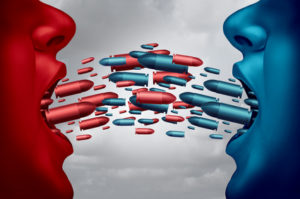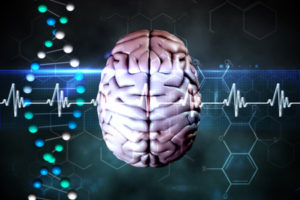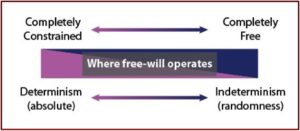Feuding Ideologies, Part 1
In August of 2017, the now former Health and Human Services Secretary, Tom Price, said he didn’t think it was necessary to declare the opioid epidemic to be a national emergency. This was despite the president’s own opioid commission recommending it as the “first and most urgent recommendation.” Two days later, the President reversed Price’s statement, saying: “The opioid crisis is an emergency, and I’m saying officially right now it is an emergency.” The response was mixed. While President Trump’s announcement could be used to help free up federal resources and help to prioritize responses to the disaster, it could also permit the administration to push for new sentencing legislation in order to get “tough on crime” related to drug use.
What isn’t disputed is that the U.S. does have a serious opioid problem and something needs to be done about it. Drug overdose is the leading cause of death in Americans under the age of fifty. Forecasts by STAT News are the annual death rate will increase by at least 35 percent by 2027. The CDC reported that from 2002 to 2015 there was a 5.9-fold increase in the overdose deaths from heroin and non-methadone synthetic opioids.
The latest statistics for the U.S. opioid epidemic is now available in the 2016 National Survey on Drug Use and Health (NSDUH). Among the myriad of statistics reported there was news that heroin users increased 230% from 2002 to 2016, while heroin deaths increased 630%. An estimated 948,000 people aged 12 or over reported they used heroin in the past year. That translates to .4% of the country’s population. There were also an estimated 11.5 million people who misused pain relievers in the past year, 4.3% of the population aged 12 or over. Combined, there are 11.8 million people who misused opioids, 4.4% of the population, in 2016.
The 2016 NSDUH Report can be accessed here. A shorter, graphic-based report of key findings, including those noted above, is here.
One of the treatment approaches often touted to address the opioid crisis is medication-assisted treatment (MAT) with Suboxone. In January of 2015, Jason Cherkis wrote “Dying To Be Free.” His subtitle asked why we weren’t using a treatment for heroin addiction—Suboxone—that actually worked. The opioid problem in Kentucky was the focus of his article, which I found to be rhetorically persuasive and well written. You are introduced to individual after individual who wouldn’t or couldn’t use Suboxone and ended up dead from an eventual overdose.
“Dying To Be Free” was a finalist for a Pulitzer in 2016 for its “deeply researched reporting on opioid addiction” that showed how many drug overdose deaths could have been prevented. The cover letter submitted for its entry for the Pulitzer by The Huffington Post said it triggered a series of state and federal policy changes that rejected abstinence for opioid misuse and embraced medication-assisted treatment. “‘Dying To Be Free’ offered readers an immersive experience that included audio and video documentaries and photo and data displays.”
This was not fake news. “Dying to Be Free” captured the agony of individuals and families who struggle with opioid misuse. But it also made abstinence-based approaches to treatment and recovery a bogeyman responsible for many of the unnecessary deaths from opioid overdoses. The rhetoric of the article was a straw man attack on abstinent-based treatment while it extolled MAT. Its biomedical treatment bias seemed to dismiss or ignore many of the problems with Suboxone as a MAT for opioid addiction. Nor did it tell the whole story behind Suboxone. It also misrepresented the recovery philosophy of self-help groups like Alcoholics Anonymous. Here’s what I mean.
In the last paragraph of his second chapter, Cherkis said: “There’s no single explanation for why addiction treatment is mired in a kind of scientific dark age, why addicts are denied the help that modern medicine can offer.” This succinctly captures the problem as he sees it with existing treatment approaches to the opioid crisis. Heroin addiction is a medical disease and should be treated as a medical disease. Modern medicine has a scientific treatment for heroin addiction that is resisted because of stigma, a deep-rooted adherence to self-help, and the criminalization of heroin addiction. If you question or oppose MAT, you are apparently mired in a kind of scientific dark age.
To enter the drug treatment system, such as it is, requires a leap of faith. The system operates largely unmoved by the findings of medical science. Peer-reviewed data and evidence-based practices do not govern how rehabilitation facilities work. There are very few reassuring medical degrees adorning their walls.
Dr. Mary Kreeft, one of the pioneers of methadone maintenance, was liberally quoted to support the medical model of addiction. She noted how opioid addiction alters multiple regions in the brain, including those that regulate reward, memory, learning, stress, hormonal response and stress sensitivity. According to Dr. Kreeft, after a long cycle of opiate addiction, a person needs specific medical treatment. Some people may be OK in time. But “the brain changes, and it doesn’t recover when you just stop the drug because the brain has been actually changed.”
An abstinence-only treatment that may have a higher success rate for alcoholics simply fails opiate addicts. “It’s time for everyone to wake up and accept that abstinence-based treatment only works in under 10 percent of opiate addicts,” Kreeft said. “All proper prospective studies have shown that more than 90 percent of opiate addicts in abstinence-based treatment return to opiate abuse within one year.” In her ideal world, doctors would consult with patients and monitor progress to determine whether Suboxone, methadone or some other medical approach stood the best chance of success.
This is a rigid, strict medical model of opioid addiction. And it gives a mixed message regarding whether or not the individual will ever be able to stop taking Suboxone or methadone. Neither drug, said Cherkis, is a miracle cure. But they buy addicts time to fix their lives, seek counseling and allow their brains to heal. So far, so good. But here comes the caution: Doctors recommend tapering off the medication cautiously. The process could take years, as addiction is a chronic disease and effective therapy takes time. Then comes the typical analogy of the pure medical model of addiction:
Doctors and researchers often compare addiction from a medical perspective to diabetes. The medication that addicts are prescribed is comparable to the insulin a diabetic needs to live.
There is no mention of neuroplasticity—the brain’s ability to reorganize itself by forming new neural connections. “Neuroplasticity allows the neurons (nerve cells) in the brain to compensate for injury and disease and to adjust their activities in response to new situations or to changes in their environment.”
Jeffrey Schwartz and Rebecca Gladding use an almost identical description of neurological action to that given above by Dr. Kreeft to describe how to change the brain; to modify bad habits (including addiction) and unhealthy thinking. In You Are Not Your Brain, they describe how we teach our brains to act in unhealthy ways. The brain does not distinguish between beneficial and destructive habits, “it just responds to how you behave and then generates strong impulses, thoughts, desires, cravings, and urges that compel you to perpetuate your habit, whatever it may be.”
Clearly, the brain can exert a powerful grip on one’s life—but only if you let it. The good news is that you can overcome the brain’s control and rewire your brain to work for you by learning to debunk the myths it has been so successfully selling you and by choosing to act in healthy, adaptive ways.
Neuroplasticity, as described by Schwartz and Gladding, does not reject Kreeft’s neurological description of addiction. But it does say it isn’t the whole story. An ideology of addiction as a purely biomedical condition seems to permeate “Dying To Be Free.” Addiction, when conceived strictly as a brain disease, rejects or ignores the non-scientific construct of mind. If we are conceived as only biological beings, then addiction is explained and treated within a biomedical worldview. Any treatment approach to addiction not based on this premise is therefore faulty.
Drug treatment facilities were said in “Dying To Be Free” to “generally” fail to distinguish between addictions. They have a one-size-fits-all approach. Addicts in residential treatment experience a “hodgepodge” of drill-instructor tough love and self-help lectures. Programs appear simultaneously excessively rigid and wildly disorganized. “And with roughly 90 percent of facilities grounded in the principle of abstinence, that means heroin addicts are systematically denied access to Suboxone and other synthetic opioids.”
After describing two older, drug treatment programs with a therapeutic community model of care that used coercive techniques—Synanon and Daytop (Drug Addicts Yield TO Persuasion)— he said:
The number of drug treatment facilities boomed with federal funding and the steady expansion of private insurance coverage for addiction, going from a mere handful in the 1950s to thousands a few decades later. The new facilities modeled themselves after the ones that had long been treating alcoholics, which were generally based on the 12-step methodology. Recovering addicts provided the cheap labor to staff them and the evangelism to shape curricula. Residential drug treatment co-opted the language of Alcoholics Anonymous, using the Big Book not as a spiritual guide but as a mandatory text — contradicting AA’s voluntary essence. AA’s meetings, with their folding chairs and donated coffee, were intended as a judgment-free space for addicts to talk about their problems. Treatment facilities were designed for discipline.
In support of this claim, Cherkis referred to a 2012 study conducted by the National Center on Addiction and Substance Abuse at Columbia University. It apparently was a reference to “Addiction Medicine: Closing the Gap between Science and Practice.” He said the study concluded the U.S. treatment system was in need of a “significant overhaul” and questioned whether the low levels of care received by addiction patients constituted a from of medical malpractice.
While medical schools in the U.S. mostly ignore addictive diseases, the majority of front-line treatment workers, the study found, are low-skilled and poorly trained, incapable of providing the bare minimum of medical care. These same workers also tend to be opposed to overhauling the system. As the study pointed out, they remain loyal to “intervention techniques that employ confrontation and coercion — techniques that contradict evidence-based practice.” Those with “a strong 12-step orientation” tended to hold research-supported approaches in low regard.
The Columbia University study did state a significant overhaul was needed in current treatment approaches; and it raised the question if the insufficient care received by addiction patients constituted “a form of medical malpractice.” It also pointed to the need for medical schools to “educate and train physicians to address risky substance use and addiction.” Unsurprisingly, it went on to say that all aspects of stabilization and treatment with addictions should be managed by a physician “as is the case with other medical diseases.” Remember that the Columbia study and Cherkis were both advocating for a physician-centered, medical model approach to addiction treatment.
However, I couldn’t find where it was supposed to have said the majority of front-line treatment workers were low-skilled and poorly trained. There was a section stating that physicians and other health professionals should be on the front line addressing addiction. Then it said: “Paraprofessionals and non-clinically trained and credentialed counselors can provide auxiliary services as part of a comprehensive treatment and disease management plan.”
It did not say the majority of front-line treatment workers were low-skilled and poorly trained “incapable of providing the bare minimum of medical care.” Yet in the case study examples found in “Dying To Be Free,” that is what Cherkis presented. The Columbia study did cite another study, which found that recovering support staff had little enthusiasm for evidence-based practices. “They also were more likely to support intervention techniques that employ confrontation and coercion–techniques that contradict evidence-based practices.” But these paraprofessionals only made up “24 percent of the treatment provider workforce.”
Cherkis seems to have mis-remembered what the Columbia study actually claimed in this matter. I wonder if, because of his commitment to a strictly medical model ideology for opiate treatment, he was reading into the study. His quote above supported the description of the treatment facilities he highlighted in his article, but wasn’t found by me in the article he cited on the Columbia study.
Another example of how his treatment ideology distorted his portrayal of Suboxone treatment was with how he described Hazelden’s Suboxone treatment program. “Dying To Be Free” mentioned that Hazelden, now the Hazelden Betty Ford Foundation, developed its own Suboxone treatment program for opioid addicts. But it failed to note this wasn’t accompanied by a rejection of “Twelve Step practices.” Within “The History of Hazelden,” on the Hazelden Betty Ford Foundation website, was the statement of how it “integrates the cornerstone Twelve Step practices of mutual support along with multidisciplinary clinical care, evidence-based therapies and the latest research in brain science.” Why weren’t there some case study examples from Hazelden in “Dying To Be Free”?
The facilities Cherkis highlighted in Kentucky were not representative of abstinent-based addiction treatment centers in the U.S.; ones that use the 12 Steps to structure their treatment program. In reading “Dying To Be Free” I see an underlying ideology of conceiving and treating addiction, specifically opiate addiction, through a strict biomedical lens. That is not the whole story of addiction. As a result, the rhetoric of the article constituted a straw man attack on abstinent-based treatment while it extolled MAT. This bias presents readers with an implied choice, a dichotomy, between Suboxone as an MAT for addiction and 12 Step, abstinent-based treatment. Ironically, Hazelden, an historically important treatment center that pioneered 12 Step, abstinence-based treatment, did not choose MAT over the 12 Step-based treatment, but combined the two. But you don’t get that information in “Dying To Be Free.”
Part 2 and Part 3 of this article will look at how “Dying To Be Free” misrepresented the recovery philosophy of self-help groups like Alcoholics Anonymous; and skimmed over the problems with MAT, specifically Suboxone.




